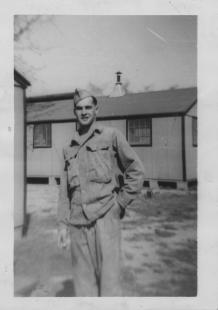Lawrence Walter Cooper
Era: World War II
Military Branch: Army

Mr. Cooper served in World War II in the Western Pacific.
He served in the U.S. Army. He signed up on May 11, 1943.
He went to boot camp in Baltimore, Maryland, and then had advanced ordnance training in Texarkana, Texas, and in Atlanta, Georgia. He was assigned to the 428th Army Ordnance Company. His approximately 400-man unit boarded a troop transport in Seattle, Washington, and fifteen days later landed at Ford Island, Honolulu. They stayed for three months. There he worked as a stationary fireman/powerhouse engineer. Then they were transported to Eniwetok, one of the Mariana Islands. A week later, his unit was sent to Saipan in the Western Pacific. That is where he spent the duration of the war.
In Saipan, Mr. Cooper was one of three engineers who took care of the boilers in a steam plant. The steam plant produced energy to allow for the manufacture of military goods in a nearby facility. Mr. Cooper’s unit was assigned to the plant and factory. Their operations ran seven days a week, 24 hours a day. The plant and manufacturing facility were sometimes attacked by the Japanese infantry.
After the war ended, Mr. Cooper boarded the USS Saginaw Bay, an aircraft carrier badly damaged by a storm at sea, and returned to San Diego.
Mr. Cooper’s highest rank was technical sergeant (T-5). He was discharged in December 1946.
The day Mr. Cooper boarded the transport to Honolulu, his first child, a son, Eugene, was born. In Duluth, Minnesota. He didn’t get to see his son until he returned, two-and-a-half years later.
Mr. Cooper received the:
Good Conduct Medal,
Western Pacific Ribbon,
American Theater Service Medal,
Asiatic-Pacific Theater Service Medal,
and three overseas service bars.
Mr. Cooper was born in Winnipeg, Canada, the son of Walter and Elsie Cooper. The family immigrated to Superior, Wisconsin, when Mr. Cooper was two years old. He graduated from Superior Central High School in 1940. When he was 21, the draft board contacted him and told him to choose: either he would have to return to Canada or join the service. He was told that if he joined the service he would finally be granted the American citizenship he had been hoping to obtain. He did receive it, shortly before being sent overseas.
Source: Veterans’ Memorial Hall interview with veteran

